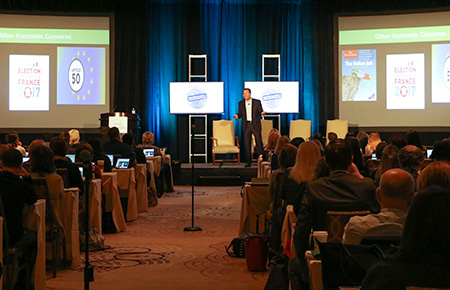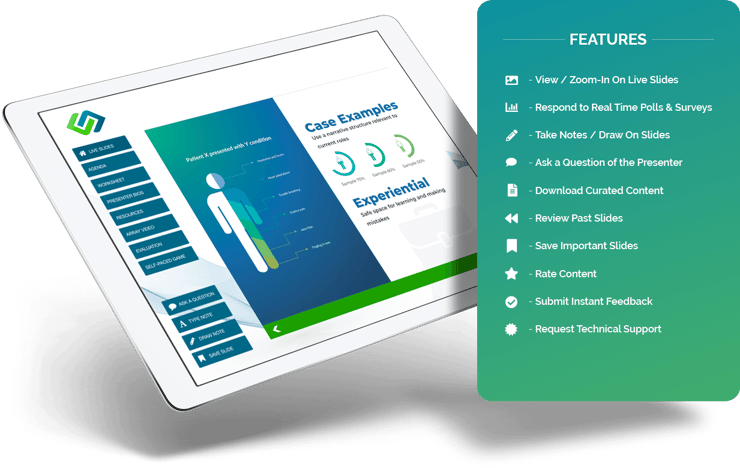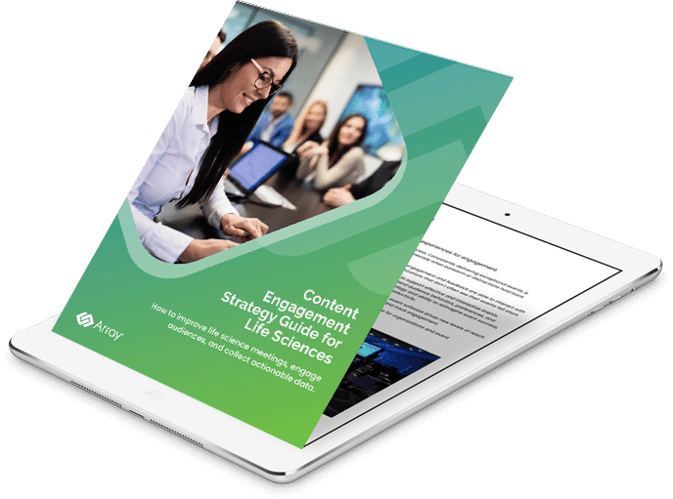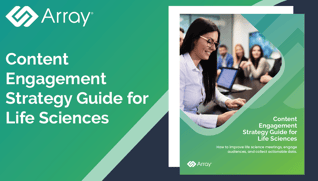Elevate Your Meeting Results with Audience Engagement
Are you looking for ways to make your life science meetings more engaging and drive more value from every meeting? This comprehensive guide covers how to create audience engagement strategies that will keep your attendees engaged throughout the event. From creating more opportunities for your participants to interact with content to measuring engagement, we have you covered.
Read more to find out how you can make your next life science meeting a success with audience engagement.
Life sciences audiences continue to evolve, as does the technology to support effective and interactive meetings. To make the most of crucial meetings, you need to understand audience behaviors, preferences, and feedback. This understanding, paired with the right technology and ability to reimagine meeting success, can help you increase meeting engagement and productivity.
No time to read?
Get the full guide in a downloadable PDF.
Why is Content the Foundation for Improving Audience Engagement?
To optimize for higher attendee engagement, meeting planners need the right event content and tools to effectively build valuable participation.
That means content engagement should be a priority for every in-person, hybrid, and virtual meeting.
What is Audience Engagement?
Audience engagement is any action attendees take to interact with your presenters and their content that provides you with data. In short, content engagement allows you to more effectively communicate with your audience and allows them to communicate with you.
Prioritizing audience engagement means rethinking event structure, activities, and tools to drive more active and engaged participants. By using event audience engagement strategies and leveraging engagement data, you can hold more effective meetings.
Survey Features

Gamification

Conversations

Slide Interactions

Accessible Resources
Why Audience Engagement Matters
Audience engagement helps audiences learn something new and share important insights.
Successful life sciences meetings use audience engagement to improve value and productivity. Leading meeting professionals understand the impact of engagement strategies.
Planning the right meeting content and interactions creates better attendee experiences. Audience engagement creates opportunities that facilitate better conversations and information exchange.

How to Set Meeting Goals
When setting event goals, it’s helpful to remember:
- Desired meeting outcomes: What do you want attendees to do?
- Meeting budget: Practically, can you achieve specific goals within your budget?
- Meeting type: For example, a virtual conference may have different KPIs from an in-person conference.
Presentation and Moderation Make or Break Meeting Success
Good presentation and facilitation play important roles in events and meetings. Even the most audience-centric meetings require the right structure to keep participants engaged and on track, rather than silent and distracted. (Check out our 10 presentation tips.)
To set the stage for the best presenters and moderators:
- Do your topic research and know your audience.
- Understand differences in knowledge and experience.
- Set times for focused responses.
- Involve quiet participants with engagement strategies.
Engaging Attendees with Content
Read more about content engagement and why it matters to your event →
Below are a few reasons why content engagement matters in life sciences meetings:
Knowledge transfer and retention are key
An engaged audience learns and retains information better. An engaging meeting creates opportunities for peer-to-peer, peer-to-presenter, and attendee-to-organization exchanges.
Impress audiences
Content engagement leaves a unique impression and helps your organization stand out. A smooth, interactive content experience provides attendees with useful materials and interactions.
Address lower virtual audience engagement
According to our 2021 Virtual Events Survey, 47% of meeting planners experience significantly less engagement in virtual event settings compared to in-person life sciences events. As more meeting go virtual to reach more people, it’s critical to plan for maximum virtual engagement.
Improve future events with data & audience feedback
To create more effective meetings, meeting professionals must identify what works and what doesn’t, as well as common audience praise and complaints. Data-driven content engagement solutions give you event analytics and gather real-time and post-session feedback.
How to Increase and Measure Audience Engagement
As a meeting planner, you put a lot of effort into planning a meeting, putting it together, and managing it to make sure everything runs smoothly. But how much do you put into generating audience engagement, capturing participation data, and measuring the impact that your meetings have?
If you are only capturing attendance data, you are missing out on tons of valuable information that can help you demonstrate value and show ROI. If you don’t measure engagement data, you’re letting improvements that need to be made for more effective meetings slip through the cracks.

Important Meeting Metrics
Engagement with presenters/sponsors
Response rates for live polls, Q&As, and surveys gather opinions and show contributions to discussion.
Engagement with each other
Activity in conversations demonstrates networking and knowledge sharing.
Content engagement
Views, notes, and downloads of important resources indicate content usefulness and attendee interest.
Event evaluations
Post-meeting feedback and post-tests assess attendance satisfaction and learning outcomes respectively.
Aggregate data
Track overall engagement to measure meeting success.
Individual data
Individual data, like engagement rate and questions answered incorrectly, can enable highly specific follow-up, which is essential for training and compliance.
Meeting Engagement Strategies
Pre-event surveys
Engage your audience from the moment they sit down, before the meeting begins. Survey responses can be a springboard as you start your meeting; responses inform speakers on the audience’s topic knowledge and interest and gather useful data for business decisions.
Q&As, polls, and surveys
Encourage attendees to participate while also helping you collect opinions and address inquiries. The more engaged your audience is, the more likely they are to retain information from the presentation.
Gamification
According to Scientific American, motivation comes from 3 critical elements: autonomy, value, and competence. Gamification features like leaderboards and polls for the fastest responders give attendees a sense of control, reward, and competitive validation.
Slide and content interactions
During the meeting, content is the main form of interaction for attendees. In fact, for virtual guests, the content becomes the meeting venue itself. Measuring slide and content interactions helps you increase audience engagement by gauging the effectiveness of certain materials.
Conversations
Encourage quiet participants to submit questions digitally, so they can have their questions answered or opinions voiced without needing to verbally speak up. By checking discussions, moderators and presenters can pull from audience questions and comments to provide answers and explore relevant topics.
Push notifications
When your meeting uses software, push notifications cut through distractions. Push notifications nudge your audience, making them a great way to get higher engagement. You can also track interactions with push notifications to evaluate interest and effectiveness.
Post-event surveys
Understanding your attendee experience is crucial to measure attendee satisfaction and guide meeting improvements. Ask quantitative and qualitative questions like “How satisfied were you with the speakers and sessions?” and “What did you enjoy most about today?”
Life sciences meetings depend on knowledge exchange. It’s no surprise that leaders in the healthcare and pharmaceutical industry are rethinking meetings as a key brand differentiator in a competitive space.
In life sciences meetings, audience engagement matters because it creates relevant learning opportunities, and addresses communication requirements to meet your organization’s goals.

Organizations are listening, measuring their audience engagement and making data-driven moves to improve experience and productivity.
Pharmaceutical Advisory Boards
To gain actionable insights and recommendations to address obstacles and support needs, pharmaceutical companies are prioritizing engagement in pharmaceutical advisory boards.
How to Increase Engagement at Medical Advisory Boards
Read more about maximizing feedback at ad boards →
Investigator Meetings
To ensure successful execution of clinical study protocol, pharmaceutical companies focus on investigator meeting engagement and attendee meeting data to identify knowledge gaps and address challenges.
How to Increase Engagement at Investigator Meetings
Read more about boosting clinical trial success
Continuing Medical Education (CME)
To engage healthcare professionals, address practice gaps, and improve organizational competence, healthcare organizations are taking an interactive and learner-focused approach in an increasingly virtual landscape.
How to Increase Engagement at CME Symposia
Read more about addressing practice gaps in healthcare →
Choosing the Right Meeting Platform
Build the necessary foundation for smoother presentations, more engaged audiences, and satisfied stakeholders.
The right meeting platform streamlines content engagement. With the right meeting technology, your meeting can successfully engage your audience and accomplish your objectives.
To pick the right meeting platform for your meeting, there are a few factors to consider. It's important to consider meeting type, engagement features, and reporting.
Meeting Format Considerations
In an increasingly digital landscape, meeting organizers need a flexible platform for a smooth experience across all types of meetings.
In-Person
Virtual
Hybrid
Engagement Features
Important engagement features for meetings include:
- Survey features
- Gamification
- Conversations
- Slide interactions
- Accessible resources

Built-In Data Reporting
With built-in data reporting, the right meeting platform gives you a deep understanding of your meeting's effectiveness.
Collect data from your audience with detailed reporting on which members engaged, which slides were compelling, cross-meeting trends, and more.
.png?width=318&name=Reporting%20(1).png)
About Array
At Array, we help life sciences organizations of all sizes and budgets increase audience engagement by 98%.
Our content engagement software, and built-in engagement analytics and reporting make it simple to define, boost, and track audience engagement. We power in-person, hybrid, and virtual meetings with content engagement technology and managed iPads.
Array Content Engagement Software
Learn about our event platform →






